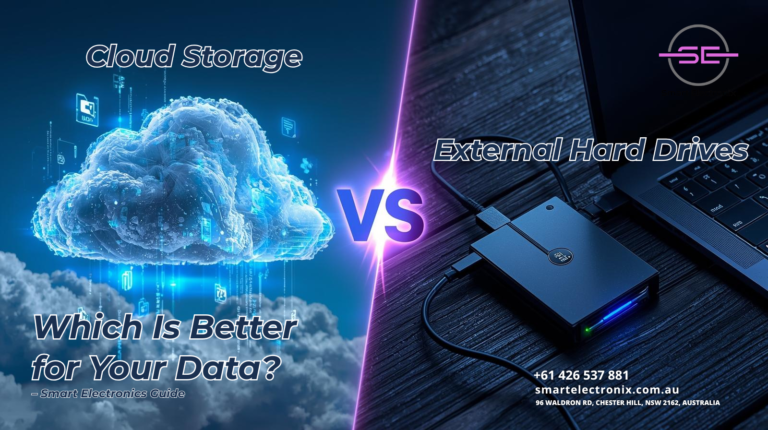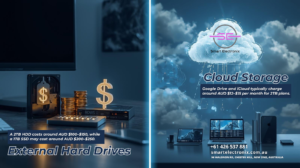
We’ve all been there—running out of space on our laptop or phone and wondering, “Where should I keep all this data?” For years, external hard drives were the go-to option, but now cloud storage has taken center stage. If you’re a student, professional, or even a casual user, deciding between the two can feel overwhelming. Don’t worry—this guide from Smart Electronics will help you understand the pros and cons of each so you can make the best choice for your needs.
Why Storage Choice Matters
Your data is valuable. From personal photos and videos to important assignments or work files, choosing the right storage option impacts not only convenience but also safety. While external hard drives offer physical control, cloud storage brings unmatched accessibility. Let’s dive deeper into both.
External Hard Drives: Pros and Cons
Pros
- One-Time Purchase – You pay once and own the device, no monthly subscription required.
- Large Storage Capacity – External drives can store terabytes of data, making them ideal for heavy users.
- Offline Access – No internet connection required to access your data.
- Fast Transfer Speeds – Especially with USB 3.0 and SSD drives, data transfer can be quick and efficient.
Cons
- Physical Vulnerability – Hard drives are prone to damage from drops, water, or wear and tear.
- Risk of Loss or Theft – If you lose the device, you lose your data unless you have a backup.
- Limited Portability – Carrying external drives isn’t always convenient for students or travelers.
Cloud Storage: Pros and Cons
Pros
- Accessibility Anywhere – Access your files from any device with an internet connection.
- Automatic Backups – Cloud platforms can sync and back up files without manual effort.
- Collaboration Made Easy – Sharing files with friends, classmates, or colleagues is seamless.
- Scalability – You can increase or decrease storage capacity as needed.
Cons
- Ongoing Cost – Monthly or yearly subscriptions add up over time.
- Internet Dependency – No internet, no access.
- Privacy Concerns – Storing sensitive data online may feel risky for some users.
Comparing Costs in 2025
 In Australia, here’s how pricing often compares:
In Australia, here’s how pricing often compares:
- External Hard Drives: A 2TB HDD costs around AUD $100–$150, while a 1TB SSD may cost around AUD $200–$250.
- Cloud Storage: Google Drive and iCloud typically charge around AUD $12–$15 per month for 2TB plans. Over a few years, this can exceed the cost of a hard drive.
So, while external drives have a higher upfront cost, cloud storage spreads costs over time.
Which Is More Reliable?
- External Hard Drives can fail due to hardware issues, accidental drops, or age.
- Cloud Storage depends on internet availability and the provider’s uptime, but major services like Google, Dropbox, and OneDrive have strong reliability.
The best solution? A combination of both—local storage for quick access and cloud backups for security.
Best Uses for Each
External Hard Drives Are Best For:
- Gamers storing large files.
- Students with limited budgets who prefer a one-time investment.
- Professionals who need offline access in areas with unreliable internet.
Cloud Storage Is Best For:
- Remote workers who need access from multiple devices.
- Students collaborating on group projects.
- Anyone who values automatic backups and file sharing.
How Smart Electronics Helps You Decide
At Smart Electronics, we understand that every user has unique needs. That’s why we:
- Provide expert recommendations tailored to your usage.
- Offer both external hard drives and guidance on setting up secure cloud storage.
- Ensure you understand the trade-offs before making a decision.
Final Verdict
So, which is better: cloud storage or external hard drives? The answer depends on your lifestyle. If you want accessibility, convenience, and collaboration, cloud storage is the way to go. If you value physical control, offline access, and one-time costs, external hard drives are a solid choice.
 For most people, the best option is a hybrid approach—using cloud storage for everyday accessibility and external hard drives for long-term backups.
For most people, the best option is a hybrid approach—using cloud storage for everyday accessibility and external hard drives for long-term backups.
Smart Electronics – Helping Australians make smarter tech choices every day.
